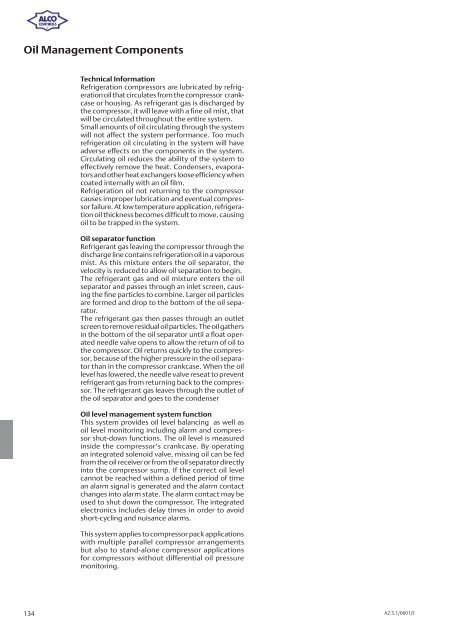Alco Controls - Grobelny
Alco Controls - Grobelny
Alco Controls - Grobelny
You also want an ePaper? Increase the reach of your titles
YUMPU automatically turns print PDFs into web optimized ePapers that Google loves.
Oil Management Components<br />
134<br />
Technical Information<br />
Refrigeration compressors are lubricated by refrigeration<br />
oil that circulates from the compressor crankcase<br />
or housing. As refrigerant gas is discharged by<br />
the compressor, it will leave with a fine oil mist, that<br />
will be circulated throughout the entire system.<br />
Small amounts of oil circulating through the system<br />
will not affect the system performance. Too much<br />
refrigeration oil circulating in the system will have<br />
adverse effects on the components in the system.<br />
Circulating oil reduces the ability of the system to<br />
effectively remove the heat. Condensers, evaporators<br />
and other heat exchangers loose efficiency when<br />
coated internally with an oil film.<br />
Refrigeration oil not returning to the compressor<br />
causes improper lubrication and eventual compressor<br />
failure. At low temperature application, refrigeration<br />
oil thickness becomes difficult to move, causing<br />
oil to be trapped in the system.<br />
Oil separator function<br />
Refrigerant gas leaving the compressor through the<br />
discharge line contains refrigeration oil in a vaporous<br />
mist. As this mixture enters the oil separator, the<br />
velocity is reduced to allow oil separation to begin.<br />
The refrigerant gas and oil mixture enters the oil<br />
separator and passes through an inlet screen, causing<br />
the fine particles to combine. Larger oil particles<br />
are formed and drop to the bottom of the oil separator.<br />
The refrigerant gas then passes through an outlet<br />
screen to remove residual oil particles. The oil gathers<br />
in the bottom of the oil separator until a float operated<br />
needle valve opens to allow the return of oil to<br />
the compressor. Oil returns quickly to the compressor,<br />
because of the higher pressure in the oil separator<br />
than in the compressor crankcase. When the oil<br />
level has lowered, the needle valve reseat to prevent<br />
refrigerant gas from returning back to the compressor.<br />
The refrigerant gas leaves through the outlet of<br />
the oil separator and goes to the condenser<br />
Oil level management system function<br />
This system provides oil level balancing as well as<br />
oil level monitoring including alarm and compressor<br />
shut-down functions. The oil level is measured<br />
inside the compressor‘s crankcase. By operating<br />
an integrated solenoid valve, missing oil can be fed<br />
from the oil receiver or from the oil separator directly<br />
into the compressor sump. If the correct oil level<br />
cannot be reached within a defined period of time<br />
an alarm signal is generated and the alarm contact<br />
changes into alarm state. The alarm contact may be<br />
used to shut down the compressor. The integrated<br />
electronics includes delay times in order to avoid<br />
short-cycling and nuisance alarms.<br />
This system applies to compressor pack applications<br />
with multiple parallel compressor arrangements<br />
but also to stand-alone compressor applications<br />
for compressors without differential oil pressure<br />
monitoring.<br />
A2.5.1/0601/E


